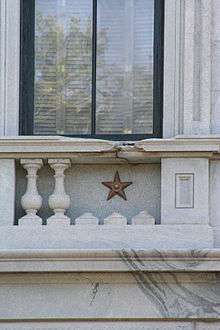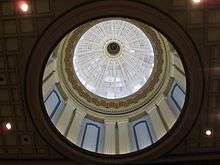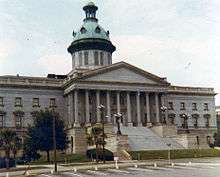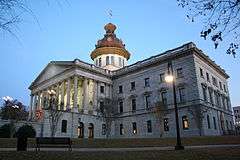South Carolina State House
|
South Carolina State House | |
|
The South Carolina State House | |
| Location | Columbia, South Carolina, U.S. |
|---|---|
| Coordinates | 34°0′1.56″N 81°1′59.33″W / 34.0004333°N 81.0331472°WCoordinates: 34°0′1.56″N 81°1′59.33″W / 34.0004333°N 81.0331472°W |
| Built | 1855 |
| Architect | John R. Niernsee; Et al. |
| Architectural style | Greek Revival |
| NRHP Reference # | 70000598 |
| Significant dates | |
| Added to NRHP | June 5, 1970[1] |
| Designated NHL | May 11, 1976[2] |
The South Carolina State House is the building housing the government of the U.S. state of South Carolina. The building houses the South Carolina General Assembly and the offices of the Governor and Lieutenant Governor of South Carolina. Until 1971, it also housed the Supreme Court.[3] It is located in the capital city of Columbia near the corner of Gervais and Assembly Streets.
The State House is in the Greek Revival style; it is approximately 180 feet (55 m) tall, 300 feet (91 m) long, 100 feet (30 m) wide. It weighs more than 70,000 short tons (64,000 t) and has 130,673 square feet (12,140 m2) of space.
Architecture



The South Carolina State House was designed first by architect P. H. Hammarskold.[4] Construction began in 1851, but the original architect was dismissed for fraud and dereliction of duty.[5] Soon thereafter, the structure was largely dismantled because of defective materials and workmanship.[6] John Niernsee redesigned the structure and work began on it in 1855, slowed during the Civil War, and was suspended in 1865 as General W.T. Sherman's U.S. Army entered Columbia on February 17. Several public buildings were "put to the torch" when United States troops entered the city.
The capitol building was damaged by artillery shells and set afire by U.S. Army troops under Sherman's command.[7]
Building work was finally completed in 1907. The reconstruction era poverty slowed progress. The building's main structure was finally completed in 1875. From 1888 to 1891, Niernsee’s son, Frank McHenry Niernsee, served as architect and much of the interior work was completed. In 1900 Frank Pierce Milburn began as architect,[8] but was replaced in 1905 by Charles Coker Wilson who finally finished the exterior in 1907.[9] Additional renovations were made in 1959 and 1998.
The State House was designated a National Historic Landmark in 1976 for its significance in the post-Civil War Reconstruction Era.[2][10]
Grounds
The building's grounds are home to several monuments. On the north side, leading to the main entry,[11] is the Confederate Monument[12] which included a flagpole flying a traditional version of the Confederate battle flag until it was removed on July 10, 2015 by State Bill. The monument was established after a controversy during the state's 2000 presidential primary about the Confederate flag flying over the dome of the State House.[13] The flag, which was originally placed over the dome in 1962[14] by the state's governor, Democrat Ernest Hollings, to protest desegregation,[15] was moved near the monument on July 1, 2000, after passage of the South Carolina Heritage Act of 2000. It was then removed from the grounds on July 10, 2015 by order of Republican governor Nimrata Haley,[16][17] and given to the South Carolina Confederate Relic Room and Military Museum.[18]
On the east side is the African-American History Monument, authorized by Act 457 of the General Assembly and unveiled on March 26, 2001.[19]
The grounds also include monuments to President George Washington, Revolutionary War Generals, the Palmetto Regiment of, the American-Mexican War, Wade Hampton III, Captain Swanson Lunsford, Confederate Women, U.S. Senators James F. Byrnes, Strom Thurmond and Benjamin Tillman, Dr. J. Marion Sims, and South Carolinian law enforcement officers killed while on duty.
See also
- Christopher Werner, maker of the "Iron Palmetto"
- List of National Historic Landmarks in South Carolina
References
- ↑ National Park Service (2007-01-23). "National Register Information System". National Register of Historic Places. National Park Service.
- 1 2 "South Carolina State House". National Historic Landmark summary listing. National Park Service. Retrieved March 24, 2008.
- ↑ "Supreme Court History". South Carolina Judicial Department. Retrieved June 16, 2011.
- ↑ Lynn Sims Salsi (2003). Columbia – History of a Southern Capital. Charleston: Arcadia Publishing. p. 50. ISBN 0-7385-2411-5.
- ↑ "SC Statehouse". South Carolina State Parks. Retrieved June 16, 2011.
- ↑ "The State House History". South Carolina State House Student Connection. Retrieved June 16, 2011.
- ↑ "The State House History". South Carolina State House Student Connection. Retrieved July 23, 2012.
- ↑ Bryan, John Morrill: Creating the South Carolina State House, page 116. University of South Carolina Press, 1999 ISBN 1-57003-291-2.
- ↑ "South Carolina Statehouse, Richland County (Main & Gervais Sts., Columbia)". National Register Properties in South Carolina listing. South Carolina Department of Archives and History. Retrieved March 24, 2008.
- ↑ Mary Jane Gregory; Ralph Christian & George R. Adams (December 1975). "National Register of Historic Places Inventory-Nomination: South Carolina Statehouse" (pdf). National Park Service. and Accompanying six photos, exterior and interior, from 1970 and 1975 (32 KB)
- ↑ Exterior Features of the State House
- ↑ "South Carolina Confederate Monument". The Historical Marker Database. Retrieved 24 June 2015.
- ↑ Jake Tapper (April 18, 2000). "John McCain to condemn Confederate flag". Salon.com. Retrieved June 16, 2011.
- ↑ Brunner, Borgna (June 30, 2000). "South Carolina's Confederate Flag Comes Down". Infoplease.com. Retrieved April 19, 2007.
- ↑ Ross, Kelley L. (December 2015). "The Police State". Political Economy. Archived from the original on March 3, 2016. Retrieved March 3, 2016.
[T]he Confederate Flag flown on the grounds of the capital of South Carolina was only put there in 1962, as a protest against Desegregation, by the Democrat Governor of the State, Ernest Hollings (Governor of South Carolina, 1959-1963, then U.S. Senator from South Carolina)...
- ↑ "South Carolina Confederate Flag Removal Bill - Video - C-SPAN.org". C-SPAN.org.
- ↑ "South Carolina Gov. Nikki Haley Signs Confederate Flag Bill Into Law". NPR.org. 9 July 2015.
- ↑ Bill 4895, South Carolina General Assembly, 113th Session, 1999-2000
- ↑ African American History Monument
External links
| Wikimedia Commons has media related to South Carolina State House. |
- South Carolina State House virtual tour
- Historic American Buildings Survey (HABS) No. SC-319, "South Carolina State House, Capitol Square, Columbia, Richland County, SC", 9 photos, 16 color transparencies, 16 data pages
- "Confederate Flag Bill Debate". C-SPAN. April 12, 2000. Retrieved June 19, 2015.
(South Carolina) State Senators debated whether to remove the Confederate flag from the Capitol building. They voted ultimately to move it from the Capitol dome to the Capitol grounds.
- "South Carolina State Senate Debate on the Confederate Flag". C-SPAN. 23 June 2015. Retrieved 25 June 2015.
The South Carolina State Senate convened for a special session to debate a procedural measure that would allow them to consider at a future date a bill that would remove the Confederate flag from the State House grounds. The resolution was passed by voice vote. The South Carolina House of Representatives had passed a similar motion, as called for by Governor Nikki Haley (R-SC). State senators also paid tribute to State Senator Clementa Pinckney, who was one of the nine people killed in the June 17, 2015, shooting at the Emanuel African Methodist Episcopal Church in Charleston.


